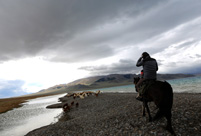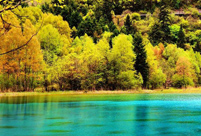 College-student-turned nun becomes famous on Internet
College-student-turned nun becomes famous on Internet
 Japanese airplanes tail Chinese warplane in China's ADIZ
Japanese airplanes tail Chinese warplane in China's ADIZ
 China applies for UNESCO listing of Nanjing documents
China applies for UNESCO listing of Nanjing documents
 Picturesque scenery in Hongcun Village
Picturesque scenery in Hongcun Village
 Japan's PM vows to resume commercial whale hunt
Japan's PM vows to resume commercial whale hunt
 Luoyang aims to become 'Chinese Culture City'
Luoyang aims to become 'Chinese Culture City'
 Century-old jade disc found confirms ancient legend
Century-old jade disc found confirms ancient legend
 A serious mind behind Chinese leader
A serious mind behind Chinese leader
 Panda Cubs to Predict 2014 World Cup Winners
Panda Cubs to Predict 2014 World Cup Winners
 China Southern Airlines flight attendants win titles in service contest
China Southern Airlines flight attendants win titles in service contest
LHASA, June 17 -- The perennial frozen earth on China's Qinghai-Tibet Plateau has shrunk by 16 percent over the past three decades as a result of global warming, according to new research results.
The volume of frozen earth on the plateau has decreased from 1.5 million to 1.26 million square km, researchers with the Chinese Academy of Sciences (CAS) found after decades of study using remote sensing and satellite monitoring.
The thawing of the frozen earth is an immediate result of global warming, as the Qinghai-Tibet Plateau, at an average altitude of 4,500 meters, is extremely vulnerable to climate change, said a research paper published by the CAS Institute of Tibetan Plateau Research and seen by Xinhua on Monday.
Meteorological data indicates the average temperature on the plateau has risen by 1.8 degrees Celsius over the past three decades, higher than the national average temperature rise.
The climate change has also caused glacial shrinking on the plateau. Its glaciers have decreased by 8,000 square km, or 15 percent, since 1980.
Satellite data indicated glacial shrinking and thawing of frozen earth had accelerated since the 1990s.
"These are detrimental to the plateau vegetation and will worsen the plateau ecology in the long term," said Jin Huijun, a researcher with CAS Cold and Arid Regions Environmental and Engineering Research Institute.
The melting glaciers have swollen lakes and rivers in the plateau region. Two years ago, Ngawang Zhoima, a herder in Namco Village of Damxung County, was forced to move to a higher altitude after a nearby river swelled and threatened to flood his home.
Though the big thaw may supplement ground water and speed up water circulation in the plateau region, Jin and his colleagues are carrying out further research to evaluate whether water resources are still properly allocated on the plateau.
Meanwhile, scientists and railway workers are striving to keep the thaw from damaging the Qinghai-Tibet Railway, the world's highest plateau rail link, which opened in 2006.
The railway, about 550 km of which runs on frozen earth, needs particular protection, as when the icy core of the earth melts, the roadbed may subside.
Thanks to effective maintenance, the railway company said recently that 99.5 percent of the frozen earth under the tracks was "solid and perfectly safe," which meant the subsidence was way below a tolerable 50 mm proposed by the designers.
 Super daddies in 2014 World Cup
Super daddies in 2014 World Cup Rebuilding the silk road
Rebuilding the silk road College girls take stylish photos to help enrollment
College girls take stylish photos to help enrollment Top 10 Chinese products scoring World Cup goal
Top 10 Chinese products scoring World Cup goal PLA units hone their tank combat skills
PLA units hone their tank combat skills Attendants shine at Xinjiang-Lanzhou high-speed rail
Attendants shine at Xinjiang-Lanzhou high-speed rail Jiuzhai Valley - fairyland of the world
Jiuzhai Valley - fairyland of the world Can't take eyes off national teams in World Cup
Can't take eyes off national teams in World Cup Beijing strips off to celebrate summer
Beijing strips off to celebrate summer
 Top 20 hottest women in the world in 2014
Top 20 hottest women in the world in 2014  China's top 10 representative architectures
China's top 10 representative architectures Cute animals' leisure summer in zoo
Cute animals' leisure summer in zoo Exhibition of the Buddha held in Tibet
Exhibition of the Buddha held in Tibet Grandpa Kang takes Gaokao for 14th time
Grandpa Kang takes Gaokao for 14th time Incredible animal migration in Xinjiang
Incredible animal migration in Xinjiang Day|Week|Month